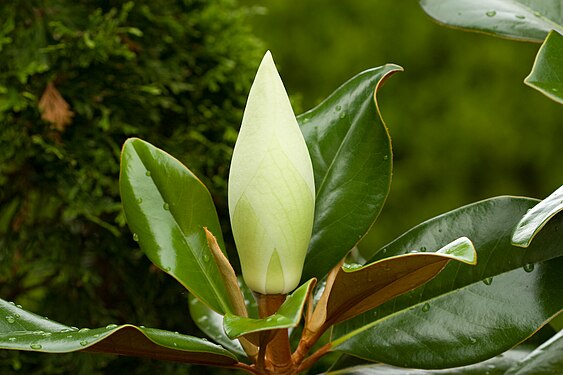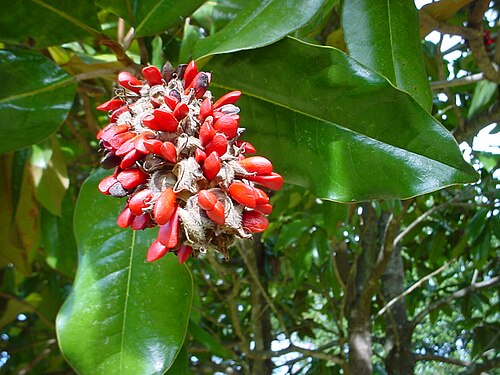Difference between revisions of "Magnolia grandiflora"
(Created page with '{{SPlantbox |genus=Magnolia |species=grandiflora |Min ht metric=cm |Temp Metric=°F |jumpin=This is the plant information box - for information on light; water; zones; height; et…') |
|||
| Line 1: | Line 1: | ||
{{SPlantbox | {{SPlantbox | ||
| + | |familia=Magnoliaceae | ||
|genus=Magnolia | |genus=Magnolia | ||
|species=grandiflora | |species=grandiflora | ||
| − | | | + | |common_name=Southern magnolia, bull bay |
| + | |name_ref=Wikipedia | ||
| + | |habit=tree | ||
| + | |habit_ref=Complete Landscaping - ISBN 9780376009272 | ||
| + | |lifespan=perennial | ||
| + | |life_ref=Complete Landscaping - ISBN 9780376009272 | ||
| + | |exposure=sun | ||
| + | |features=evergreen | ||
|Temp Metric=°F | |Temp Metric=°F | ||
| − | | | + | |min_zone=6 |
| − | |image= | + | |usda_ref=Complete Landscaping - ISBN 9780376009272 |
| + | |max_zone=9.5 | ||
| + | |image=Magnolia flower Duke campus.jpg | ||
|image_width=240 | |image_width=240 | ||
}} | }} | ||
| − | + | '''''Magnolia grandiflora''''', commonly known as the '''Southern magnolia''' or '''bull bay''', is a tree of the family [[Magnoliaceae]] native to the [[Southeastern United States|southeastern]] [[United States]], from coastal [[Virginia]] south to central [[Florida]], and west to eastern [[Texas]] and [[Oklahoma]]. Reaching 27.5 m (90 ft) in height, it is a large striking evergreen tree with large dark green leaves and large white fragrant flowers. Widely cultivated around the world, over a hundred [[cultivar]]s have been bred and marketed commercially. The timber is hard and heavy, and has been used commercially to make furniture, pallets, and veneer. | |
| − | Magnolia grandiflora, | + | |
| − | + | ''Magnolia grandiflora'' is a medium to large [[evergreen]] tree which may grow 27.5 m (90 ft) tall.<ref name=Gardiner144>Gardiner, p. 144</ref> It typically has a single stem (or trunk) and a [[Pyramid (geometry)|pyramidal]] shape.<ref name="trees_for_architecture_and_landscape_a01">{{Cite book | last1 = Zion | first1 = Robert L. | title = Trees for architecture and landscape | url = http://books.google.com/books?id=aaKTWJG4-iQC&pg=PA224&| year = 1995 | publisher = Van Nostrand Reinhold | location = New York | isbn = 978-0-471-28524-3 | page = 224 }}</ref> The [[leaf|leaves]] are simple and broadly ovate, 12–20 cm (5–8 in) long and 6–12 cm (2–5 in) broad,<ref name="trees_for_architecture_and_landscape_a01"/> with smooth margins. They are dark green, stiff and leathery, and often scurfy underneath with yellow-brown [[Leaf#Surface of the leaf|pubescence]]. The large, showy, [[citronella]]-scented [[flower]]s are white, up to 30 cm (12 in) across and fragrant, with 6–12 petals with a waxy texture, emerging from the tips of twigs on mature trees in late spring. Flowering is followed by the rose-coloured fruit, ovoid and 7.5–10 cm (3–4 in) long and 3–5 cm (1.5–2 in) wide.<ref name="Maisenhelder70"/> | |
==Cultivation== | ==Cultivation== | ||
| Line 21: | Line 31: | ||
<!--- Type pest/disease info below this line, then delete this entire line --> | <!--- Type pest/disease info below this line, then delete this entire line --> | ||
| − | == | + | ==Varieties== |
| − | < | + | Over a hundred cultivars have been developed and named in Europe and North America. More and more plants in nurseries are propagated by cuttings, resulting in more consistent form in the various varieties available.<ref name=Gardiner145>Gardiner, p. 145</ref> Many older cultivars have been superseded by newer ones and are no longer available.<ref name=Call100>Callaway, p. 100</ref> |
| + | |||
| + | As newer cultivars have been found to be more cold hardy, the cultivated range has continued to spread farther north with some being planted around Chicago. 'Bracken's Brown Beauty', [http://www.archiplanet.org/wiki/House_that_Lives%2C_The#Discussion 'Edith Bogue'] and '24 Below' are some of the most cold hardy varieties. | ||
| + | *'''''Magnolia'' "Angustifolia"''', developed in France in 1825, has narrow spear-shaped leaves 20 cm (8 in) long by 11 cm (4.4 in) wide, as its name suggests.<ref name=Gardiner145/> | ||
| + | |||
| + | *'''''Magnolia'' "Exmouth"''' was developed in the early 18th century by John Colliton in Devon. It is notable for its huge flowers with up to 20 tepals, and vigorous growth. Erect in habit, it is often planted against walls. The leaves are green above and brownish underneath.<ref name=Gardiner147>Gardiner, p. 147</ref> The flowers are very fragrant and the leaves are narrow and leathery.<ref name="the_american_horticultural">{{Cite book | last1 = Brickell | first1 = Christopher | title = The American Horticultural Society encyclopedia of garden plants | year = 1989 | publisher = Macmillan | location = New York | isbn = 0-02-557920-7 | pages = 51 }}</ref> | ||
| + | |||
| + | *'''''Magnolia'' "Goliath"''', was developed by Caledonia Nurseries of Guernsey, and has a bushier habit and globular flowers of up to 30 cm (12 in) diameter. Long-flowering, it has oval leaves which lack the brownish hair underneath.<ref name=Gardiner147/> | ||
| + | |||
| + | *'''''Magnolia'' "Little Gem"''', a dwarf cultivar, is grown in warmer climates. Originally developed in 1952 by Steed's Nursery in [[Candor, North Carolina]], it is a slower growing form with a columnar shape which reaches around 4.25 m (14 ft) high and 1.2 m (4 ft) wide. Flowering heavily over an extended period in warmer climate, it bears medium-size cup-shaped flowers, and has elliptic leaves 12.5 cm (5 in) long by 5 cm (2 in) wide.<ref name=Gardiner147/> | ||
| + | |||
| + | Other commonly grow cultivars include: | ||
| + | *'''''Magnolia'' "Ferruginea"''', has dark green leaves with rust-brown undersides.<ref name="the_american_horticultural"/> | ||
==Gallery== | ==Gallery== | ||
| Line 28: | Line 50: | ||
<gallery perrow=5> | <gallery perrow=5> | ||
| − | Image: | + | Image:Magnolia grandiflora 2004.jpg|''Magnolia grandiflora'' (Southern magnolia) – a large tree at [[Hemingway, South Carolina]] |
| − | Image: | + | Image:Magnolia grandiflora4.jpg|Bark on trunk |
| − | Image: | + | Image:Magnolia grandiflora3.jpg|Southern Magnolia foliage and flower |
| + | Image:Southern_Magnolia_Leaf_Cluster_3008px.jpg|A cluster of leaves | ||
| + | Image:2007_06_29_magnolia40.jpg|Before the Opening Act | ||
| + | Image:2007_06_29_magnolia25.jpg|Inside the Flower | ||
| + | Image:Magnoliatree.jpg|Seed cluster of ''Magnolia grandiflora'' | ||
</gallery> | </gallery> | ||
Revision as of 14:53, 29 May 2011
| Habit | tree
| |
|---|---|---|
| Lifespan: | ⌛ | perennial |
| Exposure: | ☼ | sun |
|---|---|---|
| Features: | ✓ | evergreen |
| USDA Zones: | 6 to 9.5 |
|
Magnolia > |
Magnolia grandiflora, commonly known as the Southern magnolia or bull bay, is a tree of the family Magnoliaceae native to the southeastern United States, from coastal Virginia south to central Florida, and west to eastern Texas and Oklahoma. Reaching 27.5 m (90 ft) in height, it is a large striking evergreen tree with large dark green leaves and large white fragrant flowers. Widely cultivated around the world, over a hundred cultivars have been bred and marketed commercially. The timber is hard and heavy, and has been used commercially to make furniture, pallets, and veneer.
Magnolia grandiflora is a medium to large evergreen tree which may grow 27.5 m (90 ft) tall.[1] It typically has a single stem (or trunk) and a pyramidal shape.[2] The leaves are simple and broadly ovate, 12–20 cm (5–8 in) long and 6–12 cm (2–5 in) broad,[2] with smooth margins. They are dark green, stiff and leathery, and often scurfy underneath with yellow-brown pubescence. The large, showy, citronella-scented flowers are white, up to 30 cm (12 in) across and fragrant, with 6–12 petals with a waxy texture, emerging from the tips of twigs on mature trees in late spring. Flowering is followed by the rose-coloured fruit, ovoid and 7.5–10 cm (3–4 in) long and 3–5 cm (1.5–2 in) wide.[3]
Cultivation
Propagation
Pests and diseases
Varieties
Over a hundred cultivars have been developed and named in Europe and North America. More and more plants in nurseries are propagated by cuttings, resulting in more consistent form in the various varieties available.[4] Many older cultivars have been superseded by newer ones and are no longer available.[5]
As newer cultivars have been found to be more cold hardy, the cultivated range has continued to spread farther north with some being planted around Chicago. 'Bracken's Brown Beauty', 'Edith Bogue' and '24 Below' are some of the most cold hardy varieties.
- Magnolia "Angustifolia", developed in France in 1825, has narrow spear-shaped leaves 20 cm (8 in) long by 11 cm (4.4 in) wide, as its name suggests.[4]
- Magnolia "Exmouth" was developed in the early 18th century by John Colliton in Devon. It is notable for its huge flowers with up to 20 tepals, and vigorous growth. Erect in habit, it is often planted against walls. The leaves are green above and brownish underneath.[6] The flowers are very fragrant and the leaves are narrow and leathery.[7]
- Magnolia "Goliath", was developed by Caledonia Nurseries of Guernsey, and has a bushier habit and globular flowers of up to 30 cm (12 in) diameter. Long-flowering, it has oval leaves which lack the brownish hair underneath.[6]
- Magnolia "Little Gem", a dwarf cultivar, is grown in warmer climates. Originally developed in 1952 by Steed's Nursery in Candor, North Carolina, it is a slower growing form with a columnar shape which reaches around 4.25 m (14 ft) high and 1.2 m (4 ft) wide. Flowering heavily over an extended period in warmer climate, it bears medium-size cup-shaped flowers, and has elliptic leaves 12.5 cm (5 in) long by 5 cm (2 in) wide.[6]
Other commonly grow cultivars include:
- Magnolia "Ferruginea", has dark green leaves with rust-brown undersides.[7]
Gallery
If you have a photo of this plant, please upload it! Plus, there may be other photos available for you to add.
Magnolia grandiflora (Southern magnolia) – a large tree at Hemingway, South Carolina
References
- Standard Cyclopedia of Horticulture, by L. H. Bailey, MacMillan Co., 1963
External links
- w:Magnolia grandiflora. Some of the material on this page may be from Wikipedia, under the Creative Commons license.
- Magnolia grandiflora QR Code (Size 50, 100, 200, 500)
- ↑ Gardiner, p. 144
- ↑ 2.0 2.1 Zion, Robert L. (1995). Trees for architecture and landscape. New York: Van Nostrand Reinhold. p. 224. ISBN 978-0-471-28524-3. http://books.google.com/books?id=aaKTWJG4-iQC&pg=PA224&.
- ↑ Cite error: Invalid
<ref>tag; no text was provided for refs namedMaisenhelder70 - ↑ 4.0 4.1 Gardiner, p. 145
- ↑ Callaway, p. 100
- ↑ 6.0 6.1 6.2 Gardiner, p. 147
- ↑ 7.0 7.1 Brickell, Christopher (1989). The American Horticultural Society encyclopedia of garden plants. New York: Macmillan. pp. 51. ISBN 0-02-557920-7.







